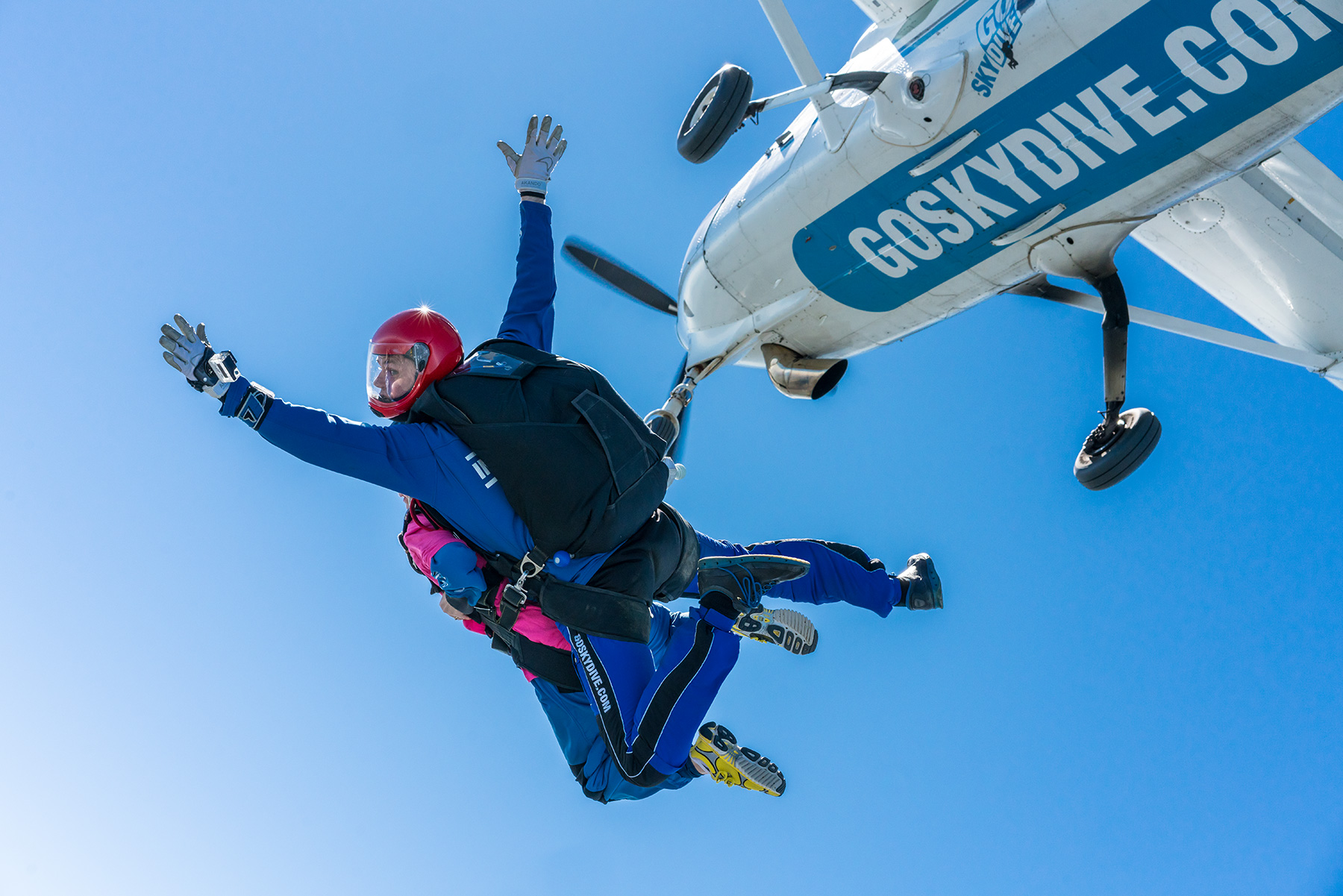
The Process at GoSkydive
17 Apr 2019
SO HERE’S WHAT YOU CAN EXPECT ON THE DAY:
1) Arrival at the office and check-in: You’ll be welcomed by our Customer Experience team who will check you in, answer any questions you may have and hand you over all the relevant forms to fill in.
2) Induction: 15 minutes after your check-in arrival time an experienced member of our team will run through a short brief of what you can expect from your experience on the day.
3) Kitting up and training: Following your brief you’ll be called through to our training centre, where you’ll learn all the important information that will make your skydive a safe and enjoyable one, familiarising yourself with our equipment and safety procedures. The equipment we use has evolved greatly since the early days and today we have the most advanced technologies and strictest processes which ensure it’s regularly tested and kept in top condition. Here you’ll learn about the body position to adopt to exit the airplane and in freefall, and how to lift your legs for landing, all in order to minimise the risks associated with this sport. At this point you’ll also meet your instructor, who will answer any questions you may have: tandem sky dive instructors are among the most experienced skydivers in the sport. All of our team are full time instructors and many of them have jumped thousands of times before; they know the plane, weather conditions and equipment inside out and will be there with you the whole time.
4) Wait: it may take up to a couple of hours, depending on weather conditions and how busy the centre is, before you’re able to board the plane. Take in the atmosphere and enjoy liaising with fellow skydivers whilst watching other divers coming in to land.
5) Boarding the aircraft: for first-time jumpers, nerves start to set in now, as our plane’s cabin is much smaller than that of commercial carriers and you’ll be sat on a bench amongst other tandem skydivers and their instructors. Yet the atmosphere is informal and jovial (far from the sometimes stuffy one of the average passenger airliner); people will be high fiving, shaking hands and getting ready for their jumps. As the plane takes off the sounds of the engines putting on gear and reaching altitude are also very powerful, but perfectly normal processes that keep the plane airborne. Fear sets in again the moment the door opens as, let’s face it, it’s probably the first time you’ve been on a plane that had its door open mid-air! This is perfectly normal: in fact, it’d be kind of strange if you were completely cool with it! Remember: just BREATHE!
6) Exiting the aircraft: When the red instructor’s pre-dive checks light is replaced by the green light, you know it’s time to start making your way towards the door. Your nerves will likely kick back in now, but if you opted to have your jump filmed, you’ll now have the welcomed distraction of waving and smiling to your camera man or your instructor’s wrist camera! In any case, once you reach the door and you look over the edge, your brain has only few short moments to let your fears kick in: the moment you’ll become aware that your instructor’s count down has already started, you’ll already be out the door and flying stably. It really all happens that quickly!
7) Freefall: ironically the moment you had envisaged yourself being the most scared is the most liberating moment of all. Rather than feeling like you’re falling downwards, you’ll actually sense being cushioned on the air. This floating sensation mixed with your adrenaline rush will make you feel a sense of complete freedom. Unsurprisingly this part of the sky dive experience happens to be the one people enjoy the most and wished they had more time of!
8) The parachute deploys: a typical concern is whether the parachute will open. Rest assured that the parachute will open so smoothly and quickly that you won’t even notice it, until the loud noise of the whooshing wind is replaced by serene quietness. This is, for many, a moment of peaceful reflection and a deep connection with life, nature around them and the world with all its beauty. Your tandem instructor will then tell you that you did great, and explain a little bit about how the parachute works and even let you handle it! If you’re the adrenaline type, however, this can be just as electrifying as the freefall stage: just ask your instructor to help you get some spins under the canopy, and your family and friends may just well hear you up there, before they even see you land! It helps to know that all sky dive centres jump with an AAD, or automatic activation device, so if we’re unable to safely deploy our own parachute, the device will deploy it for us. We also jump with two parachutes – a main and a reserve – which means, should the main fail to deploy correctly (which occurs once in 1,000 jumps on average), we have a second parachute to get us safely to the ground.
9) Landing: in the final part of your skydive it’s normal to be worried about the possibility of having a hard landing. Having practiced your landing position in our simulated training environment you’ll have learnt how to raise your legs high enough so that your instructor can touch down first and bring you in for a gentle landing, usually in a seated position. And if you’re like most of our first-time sky divers, you’ll slide safely into your smooth landing, detach from your tandem instructor and immediately ask to go back up!